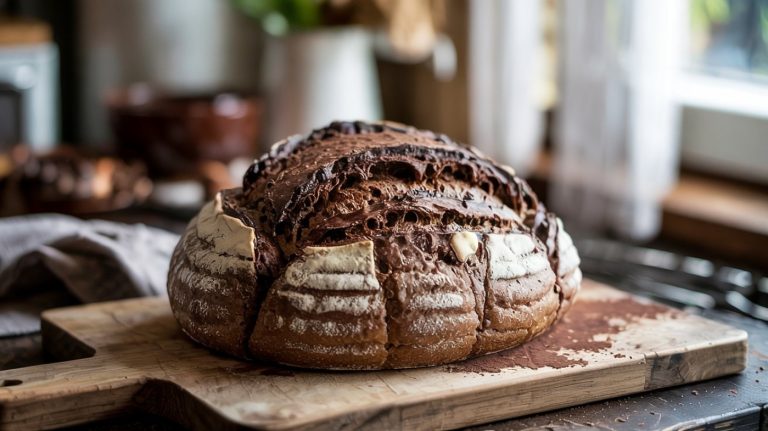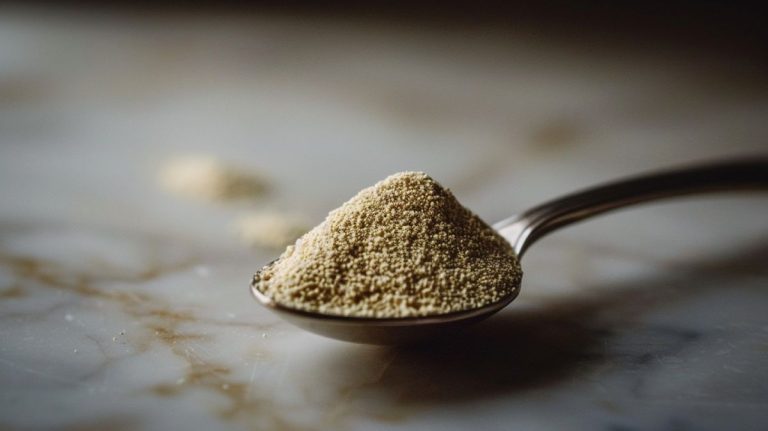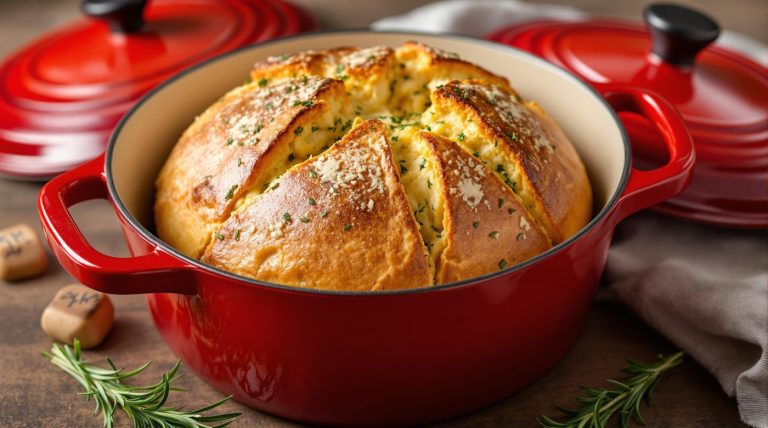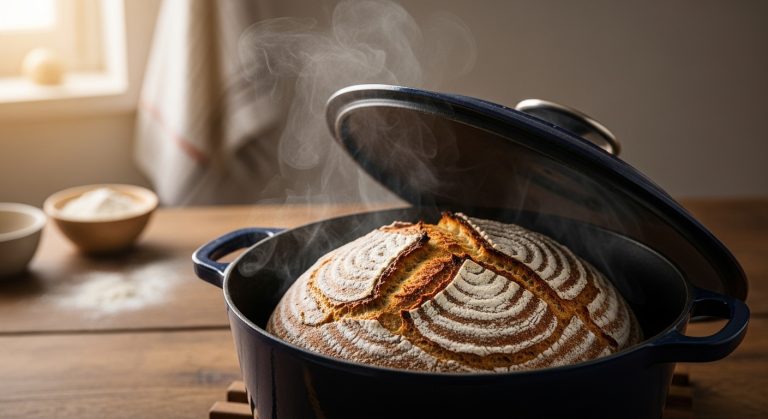Sourdough Naan Bread Recipe: Puff, Char and Flavor
You’ll love making sourdough naan bread, a delightful twist on the classic flatbread! Start with active sourdough starter, all-purpose flour, and some yogurt for moisture.
Mix your ingredients into a shaggy dough and let it rise for 5-6 hours. After lightly kneading, roll out the dough into ovals, around 1/4 inch thick.
Cook them on a hot skillet, allowing them to puff beautifully and develop those tasty charred spots. For extra flavor, brush with melted butter or add herbs.
Ready to explore variations or tips for the perfect texture? There’s so much more to discover.
Key Takeaways
- Combine all-purpose flour, yogurt, milk, and an active sourdough starter for a flavorful dough; let it rise for 5-6 hours.
- Knead the dough lightly and divide it into 8 equal pieces before rolling into oval shapes about 1/4 inch thick.
- Preheat a skillet or cast iron pan and cook naan for 1-2 minutes per side, watching for bubbles and charred spots.
- Store cooked naan in an airtight container at room temperature for up to 3 days or freeze for longer storage.
- Enhance flavor by brushing cooked naan with melted butter or experimenting with toppings like garlic, herbs, or cheese.
What Is Naan?

When you think of naan, picture a warm, soft flatbread that’s as rich in history as it’s in flavor. Originating from India and parts of Asia, naan has captivated food lovers for centuries. This traditional flatbread is known for its fluffy texture and distinctive taste, making it a staple in many cuisines.
Unlike pita, which is baked in high-heat ovens, naan is typically cooked on a hot skillet or in a Tandoor. This method creates the characteristic bubbles and charred spots that enhance its appeal. Traditionally made with all-purpose flour, naan often incorporates yogurt and milk, adding to its tender crumb and rich taste.
The first recorded mention of naan dates back to 1300 AD by the poet Amir Khusrow, highlighting its long-standing cultural significance.
Naan isn’t just limited to a plain version; you can flavor it with garlic, herbs, or even cheese, making it a versatile accompaniment to a variety of dishes.
Ingredients for Sourdough Naan
To create delicious sourdough naan, you’ll need a few key ingredients that come together to form a wonderfully flavorful flatbread. Start with all-purpose flour, which provides the perfect base for your sourdough naan dough. If you want a heartier texture, feel free to substitute half of the all-purpose flour with whole wheat flour; just remember to adjust the water by 25-50g for consistency.
For ideal fermentation, guarantee your dough is prepared using best practices for sourdough baking to enhance flavor and texture.
Next, grab some full-fat yogurt or Greek yogurt. This adds moisture and helps achieve a tender texture in your naan. You’ll also need milk, whether it’s cow’s milk or an unsweetened plant-based alternative, to further enrich the dough.
Don’t forget the oil; you can use olive oil or another neutral oil for a subtle flavor. Salt is vital for seasoning.
For the best results, guarantee your active sourdough starter is bubbly and ready to go. This is essential for ideal fermentation. If you want an extra boost in fluffiness, consider adding a bit of baking powder as a leavening agent.
Preparation Steps
Let’s get started with the preparation steps that’ll bring your sourdough naan to life!
You’ll mix the dry and wet ingredients to create a shaggy dough, then let it rise until it doubles in size, ensuring a light and fluffy texture.
After that, shaping and rolling the dough will set you up for perfectly cooked naan that puffs up beautifully in the skillet.
Mixing Ingredients Effectively
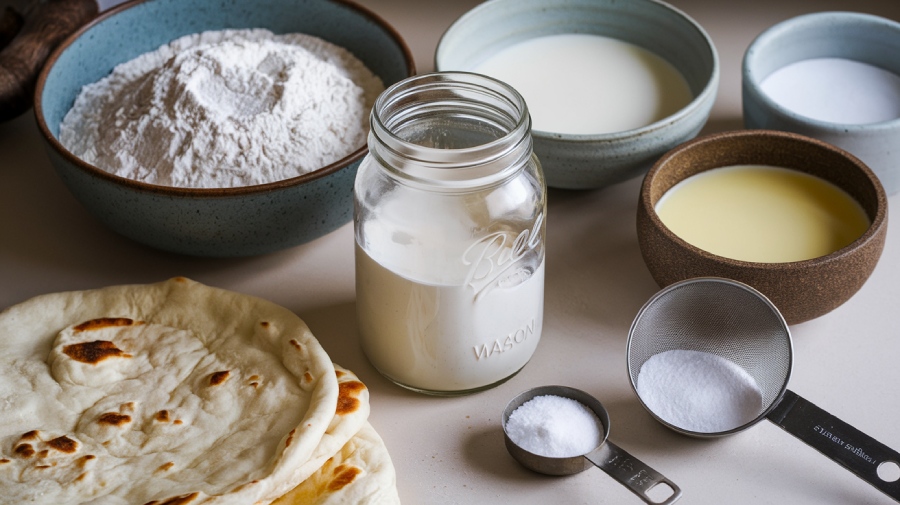
In a large mixing bowl, start by combining the dry ingredients, including flour and baking powder, to guarantee an even distribution of the leavening agents. This step is essential for achieving that perfect rise in your naan. For best results, consider using high-protein bread flour, as it supports gluten development, which is vital for a chewy texture in your naan.
Next, in a separate bowl, whisk together the wet ingredients until they’re smooth. This guarantees a consistent mixture when you combine the two. Gradually add the dry mix into the wet ingredients. Here’s what you should focus on during this process:
- Make sure all flour is hydrated
- Look for a shaggy dough consistency
- Knead lightly for about a minute
- Aim for a mostly smooth and elastic texture
- Prepare to cover and let it rise
Kneading helps develop the gluten, which contributes to the naan’s delightful texture. Once you’ve reached that ideal consistency, cover your mixed dough and place it in a warm area.
Let it rise for 5-6 hours or until doubled in size. This resting period allows the flavors to deepen, setting the stage for delicious naan.
Dough Rising Techniques
Rising dough is an essential step in crafting perfect sourdough naan, as it allows the flavors to develop and the texture to reach that desirable lightness. After mixing your ingredients, find a warm spot in your kitchen and allow the dough to rise at room temperature for about 5-6 hours. During this time, you’ll want to cover the bowl with a damp cloth or plastic wrap to keep moisture in and prevent crusting.
If your kitchen’s on the cooler side, be ready to adjust the rising time accordingly. It might take longer for the dough to rise, but patience is key! Monitor the dough at the 4-hour mark for signs of doubling, especially if you’re using a newer sourdough starter.
For a more pronounced sour flavor, consider refrigerating the dough overnight after its initial rise. This will enhance both the taste and texture.
Here’s a quick guide for your reference:
| Step | Duration | Notes |
|---|---|---|
| Initial Rise | 5-6 hours | Room temperature |
| Check for Doubling | 4 hours | Adjust if necessary |
| Refrigerate (optional) | Overnight | Enhances flavor and texture |
| Shape and Cook | Follow next steps | Enjoy your naan! |
Shaping and Rolling Tips
Once your dough has risen beautifully, it’s time to shape and roll it into the perfect naan. Start by dividing the rested dough into 8 equal pieces. This guarantees uniformity for even cooking and texture.
Lightly flour your work surface to keep things slick and prevent sticking as you roll each piece.
Here are some tips for shaping the naan:
- Roll each piece into an oval shape about 1/4 inch thick.
- Embrace a rustic appearance; perfect shapes aren’t necessary since naan is traditionally hand-shaped.
- For better texture, hand-stretch the dough instead of relying solely on a rolling pin, which allows air pockets to form.
- Keep the rolled naan covered with a damp cloth to prevent it from drying out while you prepare the next pieces.
- Don’t rush! Take your time to enjoy the process and let your creativity shine.
Cooking Instructions
To achieve the perfect sourdough naan, you’ll want to start with a well-preheated skillet or cast iron pan, so the bread puffs beautifully.
As you roll out your dough into oval shapes, keep an eye on the thickness for even cooking.
Mastering these cooking techniques will guarantee your naan turns out deliciously soft and flavorful every time.
Ingredient Preparation Tips
When preparing your ingredients for sourdough naan bread, the right combination of flours can make all the difference in achieving that perfect texture. For a balanced result, try using a mix of all-purpose and whole wheat flour. If you substitute half with whole wheat, adjust your water by 25-50 grams. This will help guarantee the dough stays hydrated.
Incorporating sourdough’s unique fermentation benefits can enhance both flavor and digestibility, giving your naan an exceptional taste.
Here are some essential ingredient preparation tips:
- Use an unfed sourdough starter directly from the fridge for extra flavor.
- In a separate bowl, whisk together the dry ingredients: flour and salt, along with baking powder.
- Mix the wet ingredients—milk, yogurt, sugar, and sourdough discard—in another bowl before combining them.
- Knead the dough for about one minute until it’s mostly smooth.
- Cover and let the dough rise in a warm spot for 5-6 hours, until it doubles in size.
These steps will help your sourdough naan recipes shine, giving you a deliciously soft and flavorful bread.
Once you’ve shaped the risen dough into balls, you’ll be ready for the next stage of cooking!
Cooking
With the dough perfectly risen and shaped, it’s time to bring your sourdough naan to life using effective cooking techniques.
Start by preheating a cast iron skillet over medium-high heat, which is essential for achieving that lovely puff and golden-brown exterior. As the skillet warms, take each portion of dough and roll the dough into a thickness of about 1/4 inch. This guarantees even cooking, preventing your naan from turning dense or chewy.
Once your skillet is hot, place the rolled naan in it and let it cook for 1-2 minutes, watching for bubbles to form on the surface. This is a good sign that it’s ready to flip.
After flipping, cook the other side while keeping an eye on the heat to avoid burning.
To elevate the flavor, brush the cooked naan with melted butter or ghee immediately after it comes off the skillet. This allows the naan to soak up that rich goodness while it’s still warm.
Skillet Temperature Importance
Achieving the perfect naan starts with understanding skillet temperature. The right heat is essential for guaranteeing your naan cooks evenly while developing that signature puff. Preheat your skillet over medium-high heat—this allows the dough to create steam, forming those delightful bubbles vital for the naan’s texture.
Here’s what you should keep in mind:
- A well-heated skillet promotes even cooking, preventing a dense texture.
- Watch for bubbling; it’s a sign your naan is rising beautifully.
- Golden spots indicate doneness; aim for a perfect balance of browning.
- Cooking each naan for about 1-2 minutes per side assures thorough cooking.
- A cast iron skillet retains heat exceptionally well, providing ideal results.
If your skillet’s too cool, the naan won’t puff correctly, leaving you with an unsatisfying chew. Conversely, if it’s too hot, the outside will burn while the inside stays raw.
Mastering skillet temperature is your ticket to achieving that perfect, fluffy naan. So, keep an eye on the heat, and you’ll be rewarded with delicious, homemade naan that’s sure to impress!
Tips for Success
A successful batch of sourdough naan starts with an active and bubbly starter, which is fundamental for achieving the perfect rise and flavor. Make certain to use proper fermentation techniques to secure your dough’s liveliness.
Before you begin, make certain your starter is lively—this will greatly influence your dough’s fermentation and taste. Once you’ve mixed your ingredients, allow the dough to rise in a warm place. Depending on your kitchen temperature, this might take about 5-6 hours, so be prepared to adjust the rising time as needed.
When it’s time to roll out the naan, don’t skimp on the flour to prevent stickiness. Aim for a thickness of about 1/4 inch; this balance is critical for proper cooking and puffing.
While you’re working on the dough, preheat your skillet over medium-high heat. A properly heated skillet guarantees even cooking and helps develop that lovely char.
If your naan doesn’t puff up, don’t fret! It may be due to rolling it too thin or not enough heat. Just tweak those factors, and you’ll be well on your way to crafting deliciously fluffy sourdough naan!
Storage and Freezing
Freezing and reheating sourdough naan is a game changer for enjoying this delicious bread at your convenience. Once your naan is cooked, you can store it at room temperature in a plastic bag for up to three days.
But if you want to keep that fresh, fluffy goodness longer, consider freezing. Place the naan in a freezer-safe container, layering parchment paper between each piece to prevent sticking. It’ll stay delicious for up to three months!
When you’re ready to indulge, reheating is simple. For frozen naan, preheat your oven to 350°F (175°C) and warm it for about 3-5 minutes. Alternatively, you can heat it in a skillet until it’s warm, guaranteeing it retains that soft texture you love.
If you’ve got refrigerated naan, let it come to room temperature before reheating to avoid a chewy or dry result.
Don’t forget to label your containers with the date you froze the naan. This helps you keep track of freshness and guarantees you enjoy it within the recommended time frame.
With these freezing and reheating tips, you can savor your sourdough naan whenever the craving strikes!
Flavor Variations
Elevate your sourdough naan by experimenting with various flavor variations that can transform this simple bread into a gourmet delight.
You can easily enhance your sourdough naan recipe by incorporating different ingredients that suit your palate. Here are some delicious ideas to get you started:
- Garlic Powder or Minced Garlic: Infuse the dough with a robust flavor by mixing in garlic powder or minced garlic.
- Fresh Herbs: Add melted butter combined with fresh herbs like cilantro or parsley for a fragrant topping.
- Cheese and Nigella Seeds: Sprinkle some cheese or nigella seeds on top before cooking for an irresistible savory twist.
- Sweet Delight: For a sweet variation, incorporate cinnamon and sugar into the dough or sprinkle it on top after baking for a delightful dessert.
- Spicy Kick: Mix in finely chopped jalapeños or chili flakes for an exciting, spicy version that’ll wake up your taste buds.
Serving Suggestions

Now that you know the nutritional benefits of sourdough naan, it’s time to explore how to enjoy this versatile bread. Sourdough naan isn’t just a side; it’s a canvas for a myriad of flavors and dishes. Here are some serving suggestions to elevate your meal:
- Pair it with rich curries, stews, or soups, letting the naan soak up every drop of flavorful broth.
- Create delicious wraps or sandwiches filled with grilled vegetables, tender meats, or creamy spreads like hummus and tzatziki.
- For an extra treat, brush the cooked naan with melted butter or garlic herb butter, enhancing its flavor and turning it into a delightful snack.
- Serve it alongside dips like baba ganoush or tzatziki for an enticing appetizer platter that’s perfect for gatherings.
- For a sweet twist, top your naan with cinnamon sugar or drizzle it with honey or maple syrup, transforming it into a unique dessert option.
Frequently Asked Questions
Can I Use a Different Type of Yogurt for This Recipe?
Absolutely, you can use a different type of yogurt!
While traditional recipes often call for plain yogurt, alternatives like Greek yogurt or even dairy-free options can work well.
Just keep in mind that the texture and tanginess might vary slightly.
If you opt for a thicker yogurt, you might need to adjust the liquid in your recipe.
Experimenting with different yogurts can lead to deliciously unique results in your dishes!
How Long Does the Sourdough Starter Need to Be Active?
When you gaze at your bubbling sourdough starter, alive with tiny gas bubbles, you know it’s ready for action.
Your starter needs to be active for about 4 to 6 hours after feeding. This is when it reaches its peak, swelling with energy and flavor.
You’ll see it double in size, a clear sign that it’s primed for baking.
Trust your senses, and don’t rush; the magic of fermentation takes time.
Can I Make Naan Without a Cast Iron Skillet?
Absolutely, you can make naan without a cast iron skillet! Just grab a non-stick frying pan or a regular skillet instead.
Preheat it over medium heat, and when it’s hot, cook your naan. You’ll want to keep an eye on it to guarantee it doesn’t burn.
Flip it when bubbles form, and enjoy that delicious, fluffy bread. Don’t forget to brush it with butter or garlic for an extra flavor boost!
What Is the Best Flour to Use for Sourdough Naan?
When it comes to making the perfect naan, choosing the right flour is key.
You’ll want to use all-purpose flour for a light, airy texture, or bread flour if you’re after a chewier bite.
If you’re feeling adventurous, try whole wheat flour for a nuttier flavor.
Each flour brings its own unique qualities, so don’t hesitate to experiment until you find the combination that makes your naan irresistible.
Happy baking!
How Can I Adjust the Recipe for Gluten-Free Naan?
If you’re aiming for gluten-free naan, it’s like trying to tame a wild stallion!
You’ll need to swap regular flour for a gluten-free blend, ensuring it’s finely milled for that perfect texture.
Add a bit of xanthan gum to mimic gluten’s elasticity.
Hydrate your dough more than usual, as gluten-free flours absorb moisture differently.
Finally, let your dough rest longer to develop flavor and improve the overall results.
Enjoy your culinary adventure!
Homemade Sourdough Naan: A Skillet Sensation
To sum up, making sourdough naan is an adventure that’ll elevate your bread game to stratospheric levels! With its soft, pillowy texture and tangy flavor, this naan will have your taste buds dancing in delight.
Don’t hesitate to experiment with different spices and toppings to make it your own. So roll up your sleeves, embrace the magic of sourdough, and serve up a batch that’ll impress friends and family like you’re a culinary wizard.
Enjoy every bite.


